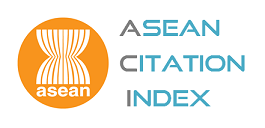ผลของการดูแลแบบแกงการูในทารกเกิดก่อนกำหนดต่อปริมาณน้ำนมมารดา
คำสำคัญ:
ทารกเกิดก่อนกำหนด, การดูแลแบบแกงการู, ปริมาณน้ำนมมารดาบทคัดย่อ
การวิจัยครั้งนี้เป็นการวิจัยกึ่งทดลอง มีวัตถุประสงค์เพื่อเปรียบเทียบปริมาณน้ำนมมารดาทารกเกิดก่อนกำหนดกลุ่มที่ได้ รับการดูแลแบบแกงการูกับกลุ่มที่ได้รับการพยาบาลตามปกติ กลุ่มตัวอย่างคือมารดาและทารกเกิดก่อนกำหนดจำนวน 32 คน คัดเลือกกลุ่มตัวอย่างแบบเฉพาะเจาะจง โดยแบ่งเป็นกลุ่มควบคุมและกลุ่มทดลอง เครื่องมือที่ใช้ในงานวิจัยประกอบด้วย 1) แบบสอบถามข้อมูลทั่วไป 2) แบบประเมินความปวด 3) แบบประเมินความเครียด และ 4) แบบบันทึกปริมาณน้ำนม วิเคราะห์ ข้อมูลโดยใช้สถิติพรรณนาและสถิติทดสอบที ผลการศึกษาพบว่าค่าเฉลี่ยปริมาณน้ำนมทั้งหมดของมารดาที่ได้รับการดูแลแบบ แกงการู เท่ากับ 4,544.20 มิลลิลิตร (S.D. = 1519.77) ค่าเฉลี่ยปริมาณน้ำนมทั้งหมดของมารดาที่ได้รับการพยาบาลแบบปกติ เท่ากับ 2,616.25 มิลลิลิตร (S.D. = 844.36) เมื่อเปรียบเทียบค่าเฉลี่ยปริมาณน้ำนมพบว่า ปริมาณน้ำนมของมารดากลุ่มที่ได้รับ การดูแลแบบแกงการูมากกว่ากลุ่มที่ได้รับการพยาบาลตามปกติ อย่างมีนัยสำคัญทางสถิติ (p < .001)
Downloads
เอกสารอ้างอิง
World Health Organization. Born too soon: The global action report on preterm birth. World Health Organization, Geneva. 2012.
Chandradey A, Mannan A, Saha L, Hossain I, & Shahidullah M. Magnitude of problems of prematurity nation and global perspective: A review. Bangladesh Journal Child Health. 2012; 36: 146-152.
National Statistical Office Ministry of information and communication technology. Key Statistic of Thailand 2012. Bankok. Thailand; 2012.
McCabe ERB, Carrino GE, Russell RB, & Howse JL. Fighting for the next generation: US prematurity in 2030. American Academy of Pediatrics. 2014; 134: 1193-1199.
Kumar C, Sharma D, & Pandita A. Late preterm and early term neonates: A new group of high risk newborn in neonatology with varied complications. Journal of neonatal biology. 2014; 3: 108-112.
Ericson J, Flacking R, Hellström-Westas L, & Eriksson M. Changes in the prevalence of breast feeding in preterm infants discharged from neonatal units: a register study over 10 year. BMJ Open 2016; 6: 1-9.
Sharon P, Melinda B, & Donna G. Breastfeeding the preterm infant. In S. Patole (Ed), Nutrition for the preterm neonate. Australia, WA: Springer science andbusiness mediaDordrecht; 2013.
Trainapakul C, et al. Effect of milk ejection performance of postpartum mothers after breasts massage and compression with mini hot bag and herbal compress. Journal of Nursing and Education. 2010; 3: 75-91. (in Thai)
Yimyam S. Galactagogue Herbs. Nursing Journal. 2018; 45(1): 133-145. (in Thai)
Boonchalerm P, Prasopkittikun T, Sangperm P. Effects of the Mother-preterm Infant Preparation Program on Breastfeeding Self-efficacy and Sucking Quality. J Nurs Sci. 2012; 30: 61-71. (in Thai)
Puapornpong P, Aimjirakul K, Relactation. Chomtho S, Dumrongwongsiri O. Clinical practice of breastfeeding. Bangkok: Beyond enterprise; 2016. (in Thai)
Chaiobhas P, Rotjananirunkit N, Boonprasert C. The effect of whole milk supplement on breast milk volume in 48 hour postpartum mothers in Ramathibodi Hospital. Ramathibodi Nursing Journal, 2009; 15: 25-35. (in Thai)
Hurst NM, Valentine CJ, Renfro L, Burn P. & Ferlic L. Skin-to-skin holding in the neonatal intensive care unit influences maternal milk volume. Journal of Perinatology, 1997; 17(3): 213-217.
Almeida DH, Venancio IS, Sanches MTC, & Onuki D. The impact of kangaroo care on exclusive breast feeding in low birth weight newborns. Jornal de Pediatria, 2010; 86: 250-254.
Sangsawang R, Punthmatharith B, Prateepchaikul L. Effect of Kangaroo care on father-premature infant bonding. Thai journal of Nursing Council. 2010; 25: 100-110. (in Thai)
Moberg MU. & Petersson. Oxytocin, a medication of anti-stress, well-being, social interaction, growth and healing. 2003.
Ludington-Hoe SM. Kangaroo care as a neonatal therapy. Newborn and Infant Nursing Reviews, 2013; 13: 73-75.
MaCaferry M. & Pasero C. Assment underlying clomplexities, miscomception and practical tool. (35-92). Missouri: Mosby. 1999.
Wongphinit U, Sinsuksai N, Yusamran C. Personal Factors, Social Support and Effective Suckling at Discharge in Predicting Exclusive Breastfeeding at one Month Among First-Time Mothers. Journal of The Royal Thai Army Nurses, 2016; 17: 88-95. (in Thai)
Sanbunsong P, Maliwan W. Quality breastfeeding: Factors influencing breastfeeding and the role of the midwife. Pathumthani University Academic Journal. 2016; 8: 235-47. (in Thai)
Phahawattakon W. Breastfeeding guideline in the postpartum period. Preechapanich; Bangkok 155-169. 2011. (in Thai)
ดาวน์โหลด
เผยแพร่แล้ว
รูปแบบการอ้างอิง
ฉบับ
ประเภทบทความ
สัญญาอนุญาต
บทความหรือข้อคิดเห็นใดใดที่ปรากฏในวารสารพยาบาลทหารบกเป็นวรรณกรรมของผู้เขียน ซึ่งบรรณาธิการหรือสมาคมพยาบาลทหารบก ไม่จำเป็นต้องเห็นด้วย
บทความที่ได้รับการตีพิมพ์เป็นลิขสิทธิ์ของวารสารพยาบาลทหารบก
The ideas and opinions expressed in the Journal of The Royal Thai Army Nurses are those of the authors and not necessarily those
of the editor or Royal Thai Army Nurses Association.







